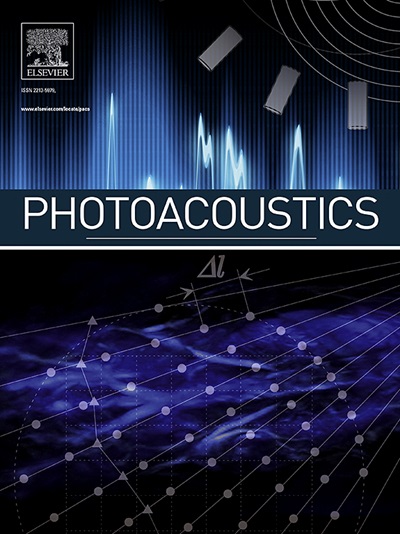Spiral volumetric optoacoustic and ultrasound (SVOPUS) tomography of mice
IF 7.1
1区 医学
Q1 ENGINEERING, BIOMEDICAL
引用次数: 0
Abstract
Optoacoustic (OA) tomography is a powerful noninvasive preclinical imaging tool enabling high resolution whole-body visualization of biodistribution and dynamics of molecular agents. The technique yet lacks endogenous soft-tissue contrast, which often hampers anatomical navigation. Herein, we devise spiral volumetric optoacoustic and ultrasound (SVOPUS) tomography for concurrent OA and pulse-echo ultrasound (US) imaging of whole mice. To this end, a spherical array transducer featuring a central curvilinear segment is employed. Full rotation of the array renders transverse US and OA views, while additional translation facilitates volumetric whole-body imaging with high spatial resolution down to 150 µm and 110 µm in the OA and US modes, respectively. OA imaging revealed blood-filled, vascular organs like heart, liver, spleen, kidneys, and surrounding vasculature, whilst complementary details of bones, lungs, and skin boundaries were provided by the US. The dual-modal capability of SVOPUS for label-free imaging of tissue morphology and function is poised to facilitate pharmacokinetic studies, disease monitoring, and image-guided therapies.
小鼠螺旋容积光声和超声断层扫描(SVOPUS)
光声(OA)断层扫描是一种强大的无创性临床前成像工具,可对分子制剂的生物分布和动态进行高分辨率全身可视化。但该技术缺乏内源性软组织对比度,这往往会妨碍解剖导航。在此,我们设计了螺旋容积光声和超声(SVOPUS)断层成像技术,用于同时对整个小鼠进行 OA 和脉冲回波超声(US)成像。为此,我们采用了一个球形阵列换能器,该换能器具有一个中心曲线段。阵列的完全旋转可呈现横向 US 和 OA 视图,而额外的平移可促进全身容积成像,在 OA 和 US 模式下,空间分辨率分别高达 150 微米和 110 微米。OA 成像显示了心脏、肝脏、脾脏、肾脏等充满血液和血管的器官以及周围的血管,而 US 则提供了骨骼、肺部和皮肤边界的补充细节。SVOPUS 的双模式功能可对组织形态和功能进行无标记成像,有助于药代动力学研究、疾病监测和图像引导疗法。
本文章由计算机程序翻译,如有差异,请以英文原文为准。
求助全文
约1分钟内获得全文
求助全文
来源期刊

Photoacoustics
Physics and Astronomy-Atomic and Molecular Physics, and Optics
CiteScore
11.40
自引率
16.50%
发文量
96
审稿时长
53 days
期刊介绍:
The open access Photoacoustics journal (PACS) aims to publish original research and review contributions in the field of photoacoustics-optoacoustics-thermoacoustics. This field utilizes acoustical and ultrasonic phenomena excited by electromagnetic radiation for the detection, visualization, and characterization of various materials and biological tissues, including living organisms.
Recent advancements in laser technologies, ultrasound detection approaches, inverse theory, and fast reconstruction algorithms have greatly supported the rapid progress in this field. The unique contrast provided by molecular absorption in photoacoustic-optoacoustic-thermoacoustic methods has allowed for addressing unmet biological and medical needs such as pre-clinical research, clinical imaging of vasculature, tissue and disease physiology, drug efficacy, surgery guidance, and therapy monitoring.
Applications of this field encompass a wide range of medical imaging and sensing applications, including cancer, vascular diseases, brain neurophysiology, ophthalmology, and diabetes. Moreover, photoacoustics-optoacoustics-thermoacoustics is a multidisciplinary field, with contributions from chemistry and nanotechnology, where novel materials such as biodegradable nanoparticles, organic dyes, targeted agents, theranostic probes, and genetically expressed markers are being actively developed.
These advanced materials have significantly improved the signal-to-noise ratio and tissue contrast in photoacoustic methods.
 求助内容:
求助内容: 应助结果提醒方式:
应助结果提醒方式:


